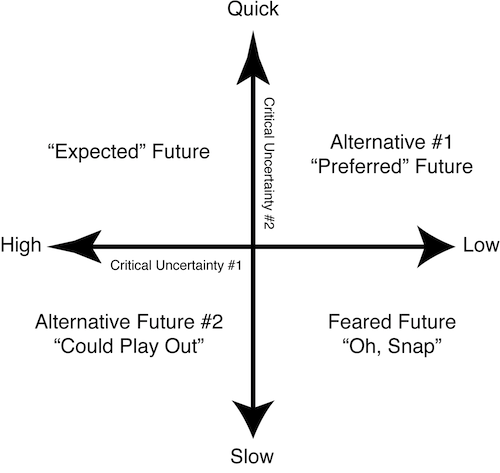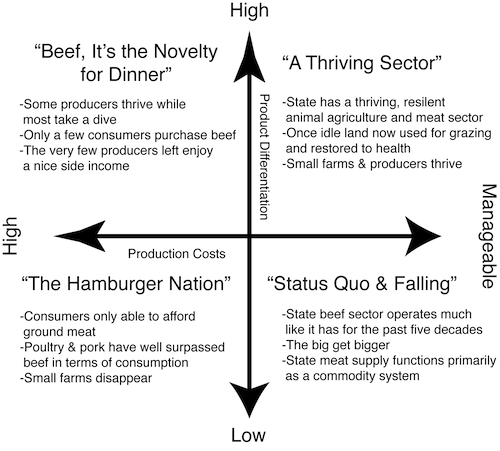 |
June
2012
|
June 2012 // Volume 50 // Number 3 // Tools of the Trade // v50 -3tt8
Extension Facilitated Scenario Planning to Direct a Preferred Agriculture Future
Abstract
One role of Extension is to
challenge clientele about what the future of a given industry may
look like. Developing a scenario is a well-established process to
help frame the question, "What might we need to do?" and
guide future planning and decision-making. To develop a plan for a
preferred future, clientele can be instructed on what futures are and
challenged to think through potential factors that can influence the
future. From this discussion, a scenarios framework outlining
plausible, probable and preferred futures can be developed. This
article incorporates the methods and outcomes of a scenario workshop.
Introduction
An important role of Extension is to assist clientele to plan for the future. Patton (1987) defined this as paying attention to past and current trends that could influence the future and then evaluating the possible different scenarios that could arise along with their consequences. One way for Extension to facilitate clientele in preparing for the future is through engaging in scenario planning. In his book, Scenario Planning: Managing for the Future, Ringland (1998) defined scenario planning as strategic planning that relates to the tools and technologies for managing the uncertainty of the future. Another goal of scenario planning is to develop thought processes that can help achieve a preferred future proactively versus the norm of responding to an event or trend reactively.
Lehtola (2007) recommended use of scenario planning to gauge preparedness in disaster situations such as wildfires, hurricanes, food contamination, and terrorism. However, scenario planning can also be useful in challenging Extension clientele to envision a "preferred future" for such efforts as natural resource management, farm business, and succession planning.
Scenario Planning Preparation
Attendees
To be successful in defining a preferred future under an identified context, meeting planning and execution are vital. Attendees from diverse backgrounds must participate in the planning session. This includes representation from a respective industry such as livestock producers and farmers. Additionally, those representing other components of the value chain must attend. This includes not only consumers, but also those who add value to a product such as distributors and retailers. Finally, policy makers who can share legal and/or political views should participate for their important contributions towards scenario planning.
Scenario Planning Education
All participants should be instructed on the exercise of scenario planning. This information could include the following.
- Voros (2001) suggested three guiding principles for describing futures in respect to a given objective. First, the future is not predetermined, and there can be infinite potential future outcomes. Second, the future cannot be predicted. Finally, present choices can influence future outcomes.
- Henchey (1977) proposed three future types. First, possible futures are those that could occur, although highly unlikely. They represent the umbrella of potential futures. Possible futures could hinge on a technology not available today. An example would be humans living on Mars by the year 2050 as a means of sparing Earth's population growth. Another important possible future is a preferred future or optimal outcome to a situation. Second, plausible futures entail possible outcomes based on current technology level and knowledge. Plausible futures entail outcomes based on "how we know it today." The third future type is probable futures that represent status quo long-term thinking. This is the expected outcome based on a continuation of current events and industry trends.
- Four scenario planning definitions exist according to Lindgren and Bandhold, (2003):
- An internally consistent view of what the future might be (Porter, 1985).
- A tool to order one's perceptions about alternative future environments in which one's decision might be played out correctly (Schwartz, 1991).
- The part of strategic planning that relates to the tools and technologies for managing the uncertainties of the future (Ringland, 1998).
- Disciplined method for imaging possible futures in which organizational decisions may be played out (Shoemaker, 1995).
Setting Up the Scenario
After the basics of scenario planning are outlined, meeting participants should be prompted to address focal questions that surround the given industry. An example of a focal question is "What will the state's beef industry sector look like in the year 2020?" Second, the question of "What might we need to do?" must then be presented. Discussion is then facilitated with a series of prompts such as:
- If faced with a given increase in the cost of input "X" (e.g., corn), what could happen to cost of output "Y" (e.g., cost of weight gain)?
- If resource "A" (e.g., nitrogen fertilizer) is minimally available, then how will it impact "B" industry (e.g., cow-calf industry)?
- If consumers are to change their attitude and perception of product "X" (e.g., beef point of production origin), what changes in business practice "Y" must occur (e.g., product traceability)?
After this discussion, a construct is developed in which two uncertainties at two different levels are compared with different future outcomes, such as the expected (plausible) future, an alternative, yet possible future, the feared future and finally the preferred future (Figure 1).
Figure 1.
Scenario Framework—Blank

An example of a completed beef production scenario involving high input prices and increased consumer demand for product differentiation is documented in Figure 2.
Figure 2.
Completed Scenario of the 2020 Beef Industry

Defining the Preferred Future
Once a scenario construct is completed, a visual depiction of four possible futures, including plausible, probable, and preferred outcomes can be developed. In Figure 2, "Status Quo and Falling" represents the continual norm and probable future of beef cattle production, while "A Thriving Sector" depicts the preferred future. Both futures under high production costs represent plausible outcomes.
Conclusion
Thinking about and subsequently planning for the future is a challenge. However, through scenario framework development an outlook can be formed to evaluate potential, plausible, and preferred futures. Once a preferred future is identified, a framework for present day decision-making is available in order to arrive at the preferred outcome.
References
Henchey, N. (1977). The future of Quebec: Alternative scenarios. McGill Journal of Education. 12(001).
Lehtola, C. J. (2007). Developing and using table-top simulations as a teaching tool. Journal of Extension [On-line], 45(4) Article 4TOT4. Available at: https://www.joe.org/joe/2007august/tt4.php
Lindgren, M., & Bandhold, M. (2001). Scenario planning: The link between future and strategy. New York, NY: Palgrave MacMillan.
Patton, M. Q. (1987). Developing an innovative culture. Journal of Extension [On-line], 25(4) Article 4FUT1. Available at https://www.joe.org/joe/1987winter/fut1.php
Porter, M. (1985). Competitive advantage. New York: Free Press.
Ringland, G. (1998). Scenario planning. West Sussex, England: John Wiley and Sons Ltd.
Schwartz, P. (1991). The art of the long view: Planning for the future in an uncertain world. New York, NY: Currency Doubleday.
Shoemaker, P. J. H. (1995) Scenario planning: A tool for strategic thinking. Sloan Management Review. 36(2)
Voros, J. (2001). A primer on futures studies, foresight and the use of scenarios. Foresight Bulletin (6). Retrieved from: http://thinkingfutures.net/resources/futures-foresight/a-foresight-primer/foresight-primer/




